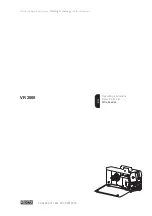
YP1225A and YP1625A
Volumetric Seeding
Great Plains |
401-625B | 6/19/19
95
Calibration
You need a light weight container for each row sampled,
and a scale that is accurate at the expected sample
weight.
Great Plains recommends using enough rows and/or
revolutions to generate a sample of about 10 pounds
(4.5 kg), ideally:
•
Use at least two rows.
•
Use no fewer than 5 meter revolutions.
1. Set the seed inlet shutters to 2 (see planter
Operator’s Manual for details).
2. Select the section and rows to be sampled.
3. Use the clutches to disconnect the other sections of
the planter.
If the planter is equipped with Swath Command™,
disable all but the tested rows.
4. Raise the planter, and install the lift cylinder transport
locks. Leave tractor hydraulic system active.
5. Bring the hydraulic fan up to planting speed (see
planter Operator’s Manual for details).
6. Press the Fill Disk key and then the Row Fill key.
This diverts all split air to seed delivery. Remain in
this mode until no more seed is flowing to meters.
Press the Work Screen key to return to the main
work menu.
7. Press the Control Setup key and then the
Channel Setup key.
8. Press the Spreader Calibration key.
9. Engage the hydraulic drive circuit.
10. Press the Fill Disk key. This turns the meters one
revolution to fill the disk cells.
11. Determine the meter revolutions needed. The
following equation gives the number of meter
revolutions needed to meter 10 pounds. The tables
on page 96 provides approximate pounds (and kg)
per revolution of each wheel and seed.
12. Configure the seed monitor for the planter and crop
(material). If the seed density is not known, use 1
pound/cubic-foot or 1 lb/bu.
13. Consult the rate chart for the crop (page 96). Note
the allowed Meter RPM range for the intended seed
disk and planting speed.
14. Place a collection bucket under each test meter’s
seed tube.
Moving Chain Hazard:
Shafts turn and chains move as soon as the Start key is pressed
on the seed monitor. Set up collection containers so that they
may be unattended. Keep all persons clear of the planter while
calibrating.
15. In the Spreader Constant Calibration screen, enter
the # Meter Revs and press the Start key.
16. Weigh the containers plus seed (
GrossWeight
).
Subtract the empty container weights to obtain the
net weight.
17. The seed monitor assumes that all rows were tested.
If you tested fewer (commonly the case), scale the
sample size to planter-wide:
18. Enter the Amount Dispensed. The seed monitor
computes a new Spreader Constant.
NOTE:
If the net weight of the metered sampled was dramatically
different than expected, run another calibration to validate
or revise the new spreader constant.
19. Perform a Ground Speed Calibration procedure.
20. Refer to “
” on page 91 to
verify seed rates.
Example:
4 containers each weighing 8 oz.
8 oz x 4 = 32 oz
ContainerWeight
at step 16 is 2 lbs
Example:
planter model with 15 inch rows
crop: Hard Red Winter wheat
PoundsPerRev
:
0.04
RowsSampled
: 4
10 / (4 x 0.04) = 62.5
Enter 63 for “# Meter Revs” at step 15.
#MeterRevs
10
RowsSampled PoundsPerRev
---------------------------------------------------------------------------
=
Example:
target population: 110 lbs/ac
desired speed: 5 mph
METER RPM: 12 rpm minimum, 45 rpm maximum
Example
:
ContainerWeight:
2 lbs
GrossWeight
: 12.88 lbs
12.88 - 2 = 10.88
NetWeight
: 10.88 lbs
Example:
NetWeight:
10.88 lbs
RowCount
: 31
RowsSampled:
4
(10.88 x 31) / 4 = 84.34
AmountDispensed
: 84.34
NetWeight
GrossWeight ContainerWeight
–
=
AmountDispensed
NetWeight RowCount
RowsSampled
--------------------------------------------------------
=


































